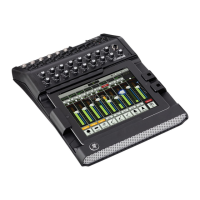Mackie DL806 and DL1608 Reference Guide
187
Glossary Of Terms Continued...
Nyquist Sampling Theorem
— This theorem states that, when an analog signal is converted to a digital
signal, it must be sampled at a frequency that is at least twice the highest audio frequency present in the
analog signal. If the audio frequency should exceed one-half the sampling frequency, aliasing may result.
Thus, if an analog-to-digital converter is sampling at 44.1 kHz, the audio signal should not exceed 22.05 kHz.
PA
—AcronymforPublicAddress.Today,peoplewhoworkwithPAsystemsliketosaythey’reworkingin
“soundreinforcement”.SeeSR.
Pan
—Panslidersareusedtoposition(orevendynamicallymove)amonauralsoundsourceinastereo
mixingeldbyadjustingthesource’svolumebetweentheleftandrightchannels.Ourbrainssensestereo
position by hearing this dierence in loudness when the sound strikes each ear, taking into account time
delay, spectrum, ambient reverberation and other cues.
Peaking
—Theoppositeofdipping.ApeakisanEQcurvethatlookslikeahill,orapeak.Peakingwith
an equalizer amplies a band of frequencies.
PFL
—AnacronymforPre-FadeListen.Broadcasterscallitcueing.Soundfolkscallitbeingabletosolo
a channel with the fader down.
Phantom Power
—Asystemofprovidingelectricalpowerforcondensermicrophones(andsome
electronic pickup devices) from the microphone input jack. The system is called phantom because
thepoweriscarriedonastandardmicrophoneaudiowiringinawaythatis“invisible”toordinary
dynamicmicrophones.TheDLSeriesmixersuseastandard+48voltDCpower,switchableonoro.
Generally, phantom power is safe to use with non-condenser microphones, as well, especially dynamic
microphones. However, unbalanced microphones, some electronic equipment (such as some wireless
microphone receivers) and some ribbon microphones can short out the phantom power and be severely
damaged.
Phase
— The time relationship between two signals, expressed in degrees around a circle. 0˚ and 360˚
representanin-phaserelationship.Bothsignalschangeinthesamewayatthesametime.Anythingelse
is out of phase.
180˚ out-of-phase is a special case which, for a continuous waveform, means that at any given time the
two signals have the same amplitude but are opposite in polarity. The two legs of a dierential output
are 180˚ out-of-phase. The polarity invert button (found in the EQ view) reverses the signal polarity.
When out-of-phase signals are mixed, there will be some cancellation at certain frequencies, the frequencies
and the degree of cancellation being a function of the amount of phase shift and the relative amplitude of
thesignals.Attentiontomicplacementandcarefullisteningwillallowyoutousethiseectcreatively.
Post Fader
—Atermusedtodescribeanauxsend(orotheroutput)thatisconnectedsothatitisaected
by the setting of the associated channel fader. Sends connected this way are typically (but not always) used
foreects.Apost-faderoutputfromamixerchannelisusuallypost-EQ.
Pre DSP
—PreDSPisidealwhenusingtheauxesformonitormixesandyouwantcompressionandother
eectsinthemainmix,butnotthemonitors.PreDSPisavailableinallauxes,butnottheFX.
Pre Fader
—Atermusedtodescribeanauxsend(orotheroutput)thatisconnectedsothatitisnot
aected by the setting of the associated channel fader. Sends connected this way are typically (but not
always) used for monitors.
Q
—Awayofstatingthebandwidthofalterorequalizersection.AnEQwithaQof.75isbroadand
smooth, while a Q of 10 gives a narrow, pointed response curve. To calculate the value of Q, you must
know the center frequency of the EQ section and the frequencies at which the upper and lower skirts
fall 3 dB below the level of the center frequency. Q equals the center frequency divided by the dierence
betweentheupperandlower3dB-downfrequencies.ApeakingEQcenteredat10kHzwhose–3dB
points are 7.5 kHz and 12.5 kHz has a Q of 2.

